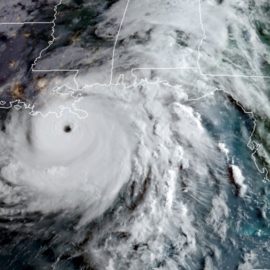
We say we are at the center for climate change. Well, we are.
The climate crisis is expected to lead to intensifying storms, heavier rains and rising seas — and Louisiana looks to be increasingly at risk. Humans have driven climate change over the past couple hundred years, largely through the burning of fossil fuels such as oil and gas. That has led to an accumulation of greenhouse gases, which trap heat in the atmosphere. Barry Keim, Louisiana’s state climatologist and an LSU geography professor, said the state might be the most vulnerable in the country to the effects of climate change. The main reason? Louisiana’s geography makes it especially prone to flood damage and sea level rise, and human activity is lowering its natural defenses.
nola.com
Erosion and subsidence
Built on the already sinking land of swamp and marsh, parts of New Orleans and many other areas of Louisiana have slowly sunk, with about 50% of New Orleans below sea level. Meanwhile, critical coastal wetlands, which can knock down storm surge waves by multiple feet, are also disappearing and sea level rise is only worsening the risks. “The coasts of the world are in the forefront of climate impact, and we’re at the leading edge,” said John Day, professor emeritus in the Department of Oceanography and Coastal Sciences at LSU. “There’s no place to hide from climate change.” Louisiana is extremely susceptible to land loss for a multitude of reasons, and the factors that speed it up are worsened by climate change. “It’s all of these factors working in concert that creates problems that are very difficult to overcome,” said Keim. The coast of Louisiana is composed of soft sediment, which is sinking both for natural and human-driven reasons. “The coastline is being eaten away both vertically and horizontally,” Keim said. This process is sped up by a few things, including rising sea levels and storm intensity. More reasons for coastal erosion include invasive species and saltwater intrusion.
Increasing hurricane intensity
As ocean surfaces get hotter, they provide storms with more energy. While this doesn’t necessarily mean more hurricanes, it likely means higher hurricane intensity. In other words, the hurricanes that do form will be more powerful. Rainfall from more intense hurricanes will heighten the risk of flood damage. Short and severe bursts of rain could mean flash flooding around the city. “If a Hurricane Harvey-like storm were to sit over New Orleans for a day, the city wouldn’t be able to pump the water out,” said Day, referring to the 2017 storm that caused major flooding from rainfall in the Houston area. “It would cause flooding all over southeastern Louisiana.”
Relative Sea Level Rise

The increase in global temperature is contributing to an overall rise in sea levels due to snow and ice melt as well as the expansion of water as it warms. Worldwide average sea level has increased by 8 inches since 1880, and is projected to increase by 10-12 inches in the next 30 years. With subsidence amounting to nearly .3 inches a year, according to Day, that must be combined with NOAA’s projections of sea level rise of about .46 inches to .6 inches on average each year for the Gulf Coast. Relative sea level rise is the combination of sinking land and rising sea level, which “might be greater in Louisiana than in any place in the country and, quite possibly, the world,” said Keim.
Levees
Levees, which act as the protector of the Greater New Orleans area, are also increasing its risk. By preventing the natural flooding process of the Mississippi River, levees stop sediment from replenishing wetlands and marshes. That speeds along the process of erosion and subsidence.
Activities of oil and gas companies
When oil and gas companies extract resources from the Mississippi River Delta, they weaken the already soft land. A study published in March 2023 found that oil and gas exploration and fluid extraction cause increased rates of subsidence. The thousands of miles of canals dug for oil and gas exploration and pipeline installations have also damaged essential wetlands. Dean Wilson, founder of the Atchafalaya Basinkeepers organization, has seen first-hand how the building of canals by oil companies can destroy critical areas. “Not only are the wetlands and the Atchafalaya Basin important,” said Wilson. “It would be impossible to survive without the flood protection that the Atchafalaya Basin provides. It’s everything for the state of Louisiana.”

(Coastal Protection and Restoration Authority)
What does this mean for Louisiana’s future?
When combining what is known about Louisiana’s disappearing coast with intensifying storms and rising sea levels, the outcome is worrying. Relative sea level rise and rainfall from stronger storms put New Orleans at increased risk of flood damage day by day. In an already vulnerable state, Louisiana’s protection is also decreasing as land subsides and erodes. Intense storms weaken wetlands even more, and it becomes a vicious cycle of continuous erosion and damage. “The climate has gotten so extreme that it’s passing tipping points of no return,” said Day. “We’re not going to avoid catastrophic impacts, but we might be able to minimize them.”
What’s being done?
By understanding the reality of the danger the state is in, action can be taken to preserve and protect it to certain degrees. Louisiana’s coastal master plan, updated every six years, calls for $50 billion to be spent over 50 years on coastal restoration and flood protection projects. Two key elements of that plan are the Mid-Barataria and Mid-Breton Sediment Diversions. They aim to partially rebuild wetlands in those two areas by channeling Mississippi River sediment – mimicking the process that used to occur before the levees were built. Louisiana will also have to play its part in reducing greenhouse gas emissions, which are causing the climate change that exacerbates sea level rise. Gov. John Bel Edwards has developed a climate action plan with the goal of reaching net zero greenhouse gas emissions by 2050.
We need a legislature that cares and not all representatives do.


